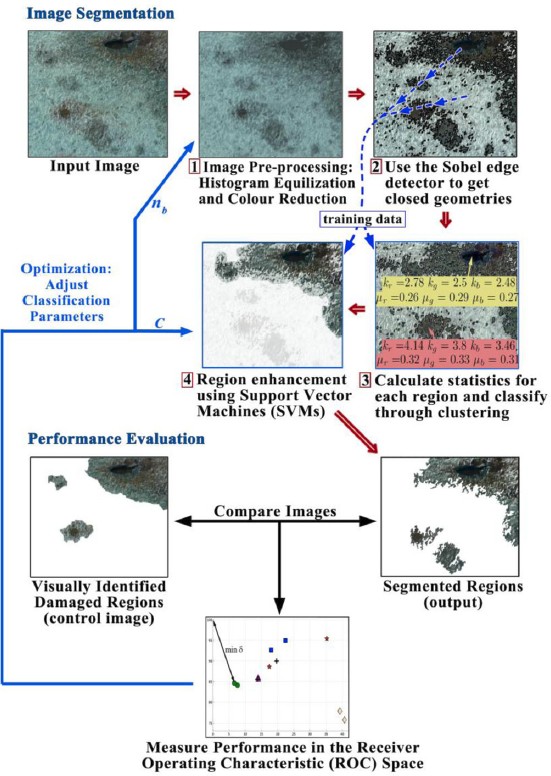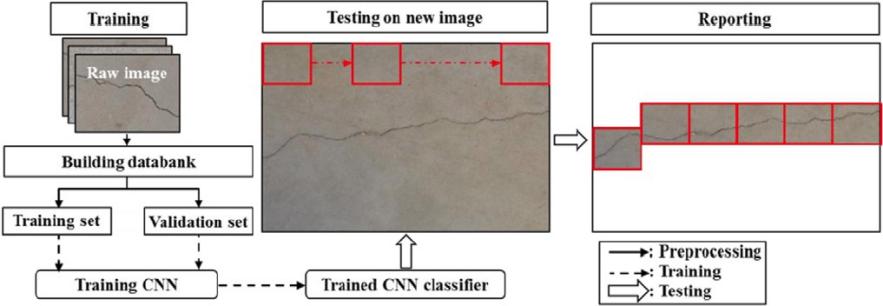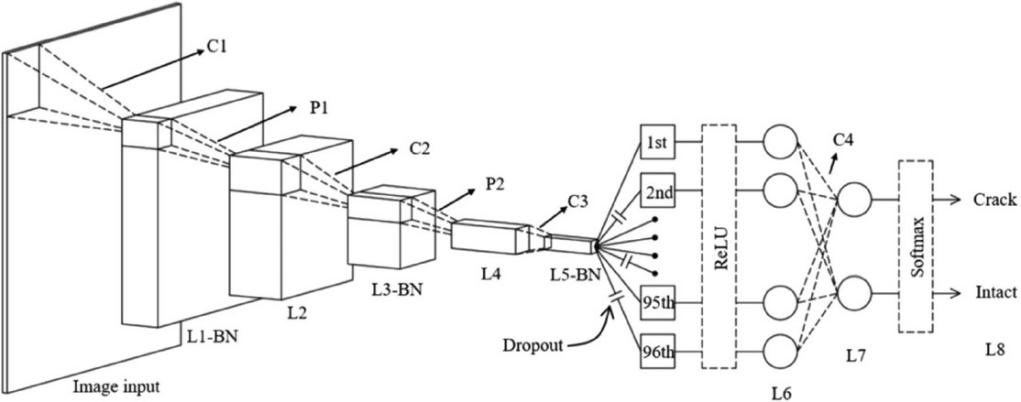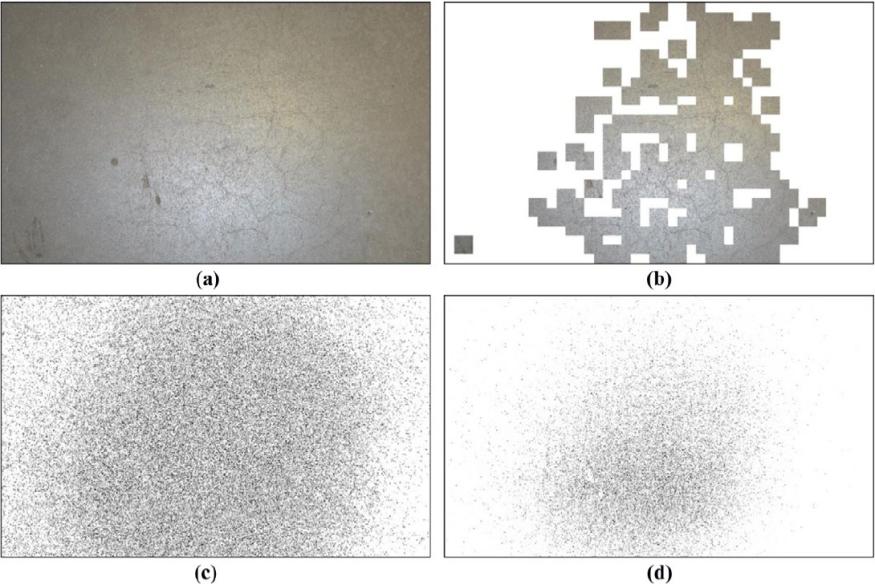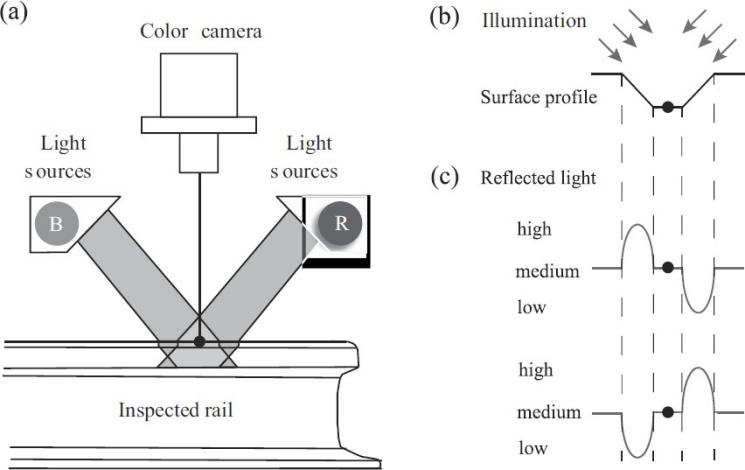1. Introduction
There are many existing SHM frameworks, with each one having its own advantages and disadvantages. Vibration-based and sensor-based are two important topics that will be addressed below:
The identifications of vibration-based structural system through numerical method conjugations have been used. At the same time, there are still several challenges to monitor large-scale civil infrastructures utilizing this approach [1].
For large-scale SHM, many are required including installing sensors largely, integrating data from distributed sources, and taking environmental effects into consideration.
Affirming the fact whether the collected data presents structural damage, sensory system malfunction, noisy signals, or anything that are combined with all of this is relatively difficult before checking structures and the sensing systems in person. In the end, quite a few strategies to recognize damages, essentially utilizing image processing techniques (IPTs) are suggested. And one solution possible to be realized with more practical situation adaptability in the real world is utilizing machine learning algorithms (MLAs) [2]. These approaches to begin with receive signals from nondestructive testing and assess the collected signals to be either show problems. In recent decades, there are numerous existing researches in this particular field. A few normal methods are listed underneath:
IPT-based combination image feature extractions and MLA-based classifications [3].
Different kinds of artificial neural networks and probabilistic neural networks [4].
CNNs successfully capture the grid-like topology of images, not like the standard NNs, and they fewer computations are required [5-6].
For next part, this article will primarily examine three papers pertinent to image processing techniques for SHM systems [3, 6-7].
2. Machine learning based SHM methods summary
2.1. Enhanced multiphase segmentation technique for detection of civil infrastructure
2.1.1. Algorithm. This article exhibits an unprecedented regionally enhanced multiphase segmentation (REMPS) technique. REMPS comprises of three stages: identification, classification, and enhancement [3]. The primary stage produces closed geometries by generally distinguishing object boundaries in a picture utilizing the Sobel edge finder. The stage of classification has regions retained enclosed by a defined boundary that represents damaged zones by utilizing the filtering technique of clustering-based. The ultimate stage is devoted to improving the concept of damaged regions through regionally supporting the location with pixels got through support vector machine (SVM) classification.
The REMPS technique coordinates 3 feature detection methodology. A flowchart describing the sequence of the feature detection methodology is displayed in Figure 1. The damage distinguishing procedures in the first stage includes creating a temporary picture contrasted with operation enhancement and color reduction. These procedures enable the boundaries of our highlights in a scene more clear and focus our afterwards analysis on crucial districts. After the region-based clustering arrange, many damaged pixels around the fringe of the location still exists and remains undetected. Conducting SVM classification within the neighborhood of the locations and then regionally supporting the closed geometries with the SVM pixels generates more well-defined features of highlights.
|
Figure 1. REMPS flowchart. |
2.1.2. Conclusion. REMPS is in contrast with newly established identification techniques, such as Otsu’s Method, Chan-Vese Method, Delaunay triangulation, region growing, and graph-based segmentation. The comparison is aimed at highlighting the efficiency of REMPS in connection to the other segmentation techniques. About the results in Table 1, REMPS embraces a multiphase segmentation technique which consolidates highlights from 3 regular picture processing and data analysis methods. Because these methods are accepted by people and portrayed in the literature, REMPS could be replicate and implemented without much of difficulty. A good thing about REMPS is in its capacity to deliver way better defined and more similar regions of our highlights while under no circumstances get influenced by separated unessential pixels.
2.2. CNN method for detecting concrete cracks
2.2.1. Algorithm. In this paper [7], Cha embraced CNNs to set up a classifier to identify concrete break down from pictures. The primary goal article is trying to achieve is building a strong classifier that's much less affected by noise generated from lighting, shadow casting, obscure, and other sources and to make sure of adaptability largely. The second goal is to launch a test bed that could permit another 5 analysts to identify extra kinds of structural damage, including delamination, voids, spalling, and corrosion of concrete and steel members. The most advantageous effect of the suggested CNN-based concrete breaks detection is the requirement of zerio feature extraction and calculation compared with previous methods.
Figure 2 presents the general flow of the approach with training process (solid lines) and steps of tests (dashed lines). To prepare a CNN classifier, raw pictures showing concrete surfaces with a wide scope of picture varieties, counting lighting, shadow, and anything that are able to possibly activate wrong alarm cautions, are shot through a complicated engineering building employing a DSLR camera. The concept of a break down here as we talked about is that it ought to be recognized in pictures by naked human eye. The pictures are edited into small pictures, which are selected to generate training and validation sets on a random basis. The arranged picture collection is organized into a CNN for the purpose of building a CNN classifier to isolate broken pictures through intact concrete pictures within the approval set. During the time the CNN classifier is assessed through the approval collection of pictures within the DB, 55 extra concrete pictures with 5,888 × 3,584-pixel resolutions are shot and checked by the approved classifier for the purpose of creating a report of broken damages.
|
Figure 2. Flowchart for detecting concrete cracks. |
A convolution layer carries out three duties through an input array as appeared in Figure 3. To begin with, it conducts element-by-element multiplications within a subarray of an input cluster and a receptive field. The receptive field has another name of the filter, or sometimes kernel. The starting values of a receptive field weight are regularly generated at random. Further, values are multiplied and are counted in sum, and bias is also included in the total value sum. To pick one pro of highlights in convolution, when the input data size decreases, computational cost diminishes. The stride is an extra hyperparameter of the layer. The stride characterizes the number of the columns in the receptive field and columns (pixels) slide once over the height and width of input array. The stride is large in size which results in a shortage of receptive field applications and a small size of output, both of which diminishes computational cost as well, in spite of the fact that it could be increasingly missing input data. The output size of convolution layer is calculated by the equation appeared in Figure 3.
|
Figure 3. Overall architecture |
2.2.2. Results. In Figure 4 the Sobel and Canny methods give no significant outcome, as appeared in Figure 4d. Nevertheless, the suggested CNN identifies break downs precisely. In these contrasted researches, the suggested technique appears to be exceptionally strong in break down detection under different kinds of situations of the raw pictures contrasted with any of the conventional Canny and Sobel techniques. The operation of the trained CNN was assessed on 55 expansive pictures with 5,888 × 3,584 pixels resolutions. The pictures tested were checked through the trained CNN employing technique called sliding window, enhancing the function to filter the pictures bigger than 256 × 256-pixel resolutions, and the break down maps were subsequently obtain. The test presented a steady improvement in spite of the fact that test pictures taken under different conditions and locations, such as strong lighting spot, shadow, obscure, and close-up. In addition, the performance of the suggested strategy was not helpless in helping pictures qualities, camera specification, and working distance.
2.3. CNN method for steel surface defect detection
2.3.1. Algorithm. Within the photometric acquisition setup, a dark-field acquisition setup is built up to enable deviations to be seen from a continuous surface, for example, illumination only scatteres back to the sensor in places where cavities or small hills form, see Fig. 6(a). For segregation purposes, discriminating between cavities and hills and other one use spatially localized reflection behavior around the locale in question. Fig. 5(b) appears an idealized cavity to be identified through analysis in the correlated sensor responses generated from cavity edges as in Fig. 5(c). A CNN may be a multi-layer neural architecture that's particularly fit for the handling data in pictures. The three types of layers include convolutional layers, pooling layers, and one final fully connected layer. A convolutional layer comprises of a filter bank and produces a settled number of output pictures (output maps) from some input pictures (input maps). The input maps are screened with the correlated filters, all filters’ outcome closely correlated to the same output map are gathered (e.g., summed) and a learnable bias value is included. Consequently, the output maps are produced by using a nonlinear function (e.g., tanh) and applying to all yield outline pixels.
|
Figure 4. Thin crack with lighting: (a) original image, (b) proposed CNN, (c) Canny edge detection, and (d) Sobel edge detection. |
2.3.2. Results. They prepared CNNs on photometric stereo pictures of rail surfaces in a dark-field setup to identify rail surface defects. Up to present this classification mission has been fulfilled by a model-based approach. In any case, the detection performance of the CNNs appeared to be essentially superior than the model-based approaches. In addition, we may illustrate how overfitting due to the relatively small training data set could be alleviated by the use of regularization methods, i.e., unsupervised layer-wise pre-training and training data increases. Regularization progressed the recognition rates further more. In future work, we need to expand the classification mission to more classes, for the purpose to recognize diverse kinds of defective and non-defective rail surface structures, whereby deeper CNNs may be required.
|
Figure 5. Acquisition setup and model of reflection properties: (a) top-down view of the head surface using a line camera and illumination by different line light sources under oblique angles, (b) distorted surface profile and direction of illumination sources, (c) model of reflectance for a distorted surface profile. |
3. Conclusion
Machine learning strategies for Structural Health Monitoring (SHM) have emerged as more effective than conventional strategies in recent research. These strategies offer distinct types of enhancements and tricks for the models, leading to improved performance in SHM applications. One notable approach is the use of the regionally enhanced multiphase segmentation (REMPS) technique, which incorporates a Support Vector Machine (SVM) for model training. Research papers have shown that this approach outperforms other methods in SHM applications. The REMPS technique takes advantage of regional information to enhance the accuracy of the segmentation process, resulting in more reliable and robust SHM results. Furthermore, recent studies propose the use of Convolutional Neural Networks (CNN)-based detection strategies for concrete cracks and rail surface defects. These CNN-based methods have demonstrated high performance in crack detection from raw images under various conditions, outperforming traditional approaches. The ability of CNNs to automatically learn features from images and effectively capture complex patterns has made them a promising tool for SHM applications. Overall, machine learning strategies are becoming increasingly important in addressing SHM challenges. These strategies offer improved accuracy, robustness, and efficiency compared to conventional methods. By leveraging advanced techniques such as REMPS with SVM and CNN-based detection, SHM practitioners can achieve more reliable and effective monitoring of structural health, leading to enhanced safety, maintenance, and cost-effectiveness in civil infrastructure and transportation systems. As research in this field continues to advance, machine-learning strategies are expected to play a key role in the future of SHM.
4. Acknowledgments
Thank you for professor Oral’s wonderful lecture on different aspects of structural analysis and design. I gained a lot during these weeks and have a deeper understanding of civil engineering and architectural structures. Discussion of research papers makes me familiar with the structure and principle of a research paper. While writing this research paper, I got to know the cutting-edge method for SHM and the powerful strength of the machine learning method.




